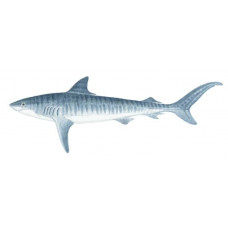Latin name
Galeocerdo cuvier
Other names
Tiger shark
Identification
Dark bluish-gray or brownish-gray above and whitish below, the tiger shark is so called because of its noticeable dark brown spots and stripes, or "tiger stripes and leopard spots," which are especially noticeable in young and small adults, but disappear with age. This fish has an extremely blunt snout, which appears broadly rounded from below, and a median dorsal ridge is present. The Tiger shark is also characterized by its broad and coarse-toothed teeth, which have deep notches and are identical on both jaws. The first two of the five gill slits are located above the pectoral fin, there is a long prominent keel on either side of the caudal processor, as well as a long upper blade on the tail.
Distribution
No information
Habitat
The tiger shark is often found in the shallow waters where people swim, and is circumnavigated in tropical and temperate waters. One study revealed that a tiger shark can travel more than 30 miles in 24 hours, and although tiger sharks visit the same coastal areas, the time between visits can vary from a few days to many months.
Size
It grows up to 24 feet. The Tiger shark is an important species for anglers only because it usually weighs between 300 and 800 pounds, but it can grow much larger. The long-standing record for all-tackle catches, 1,780 pounds, was caught from a pier in Cherry Grove, South Carolina, in 1964.
Life history and Behavior
No information
Food and feeding habits
Some sharks attack and kill people, but not necessarily by eating them. The Tiger shark is especially scary because it is known as an ogre, often devouring the remains of its victims. Tigers are notorious for eating just about anything, including metal objects, and are generally bad fighters.
Reproduction
No information
| Classification | |
| Phylum | Chordata |
| Class | Chondrichthyes |
| Squad | Carcharhiniformes |
| Family | Carcharhinidae |
| Genus | Galeocerdo |
| Species | G. cuvier |
| Features | |
| Conservation status | Near Threatened |
| Habitat | Pelagic |
| Life span, years | 12 |
| Maximum body weight, kg | 635 |
| Maximum length, cm | 500 |
| Sailing speed, m/s | No information |
| Threat to people | Edible |
| Way of eating | Predator |



